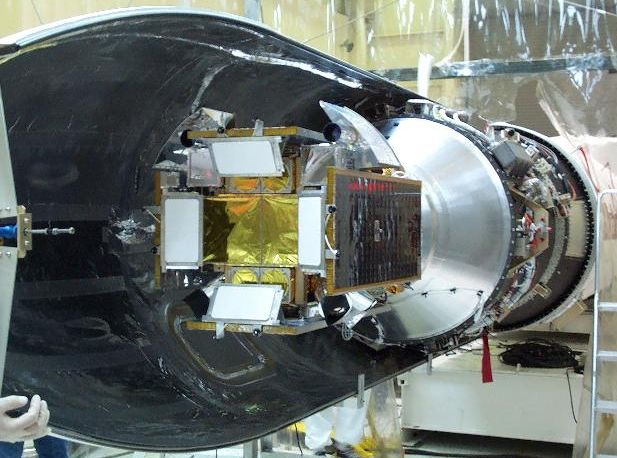Explanation: The Stargazer, a modified Lockheed L-1011 aircraft, soared into the skies above Kwajalein Atoll in the pacific on October 9th. A small satellite observatory known as the High Energy Transient Explorer - 2 (HETE-2) was tucked into Stargazer's winged Pegasus rocket, slung beneath the large trimotor jet's fuselage. Dropped from its mother ship, the Pegasus then successfully flew HETE-2 into orbit. HETE-2's mission is to hunt gamma-ray bursts, brief, random flashes of high energy photons from the distant cosmos. Gamma-ray bursts are impressive, believed to be the most powerful explosions in the Universe, but so few have been well located and studied that the nature of the bursters themselves is still shrouded in mystery. HETE-2's x-ray and gamma-ray instruments will be able to rapidly alert ground-based observatories to point toward ongoing, bright gamma-ray bursts. Communications antennae and solar panels neatly folded, HETE-2 is seen here being carefully enclosed in the Pegasus nose fairing.
1999 2000 2001 2002 2003 2004 2005 2006 2007 2008 2009 2010 2011 2012 2013 2014 2015 2016 2017 2018 2019 2020 2021 2022 2023 2024 2025 |
Январь Февраль Март Апрель Май Июнь Июль Август Сентябрь Октябрь Ноябрь Декабрь |
NASA Web Site Statements, Warnings, and Disclaimers
NASA Official: Jay Norris. Specific rights apply.
A service of: LHEA at NASA / GSFC
& Michigan Tech. U.
|
Публикации с ключевыми словами:
гамма-всплески - gamma-ray burst - hete-2 - pegasus - ракета Пегас - спутник
Публикации со словами: гамма-всплески - gamma-ray burst - hete-2 - pegasus - ракета Пегас - спутник | |
См. также:
Все публикации на ту же тему >> | |
